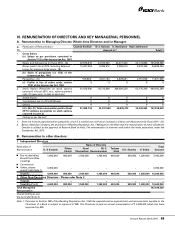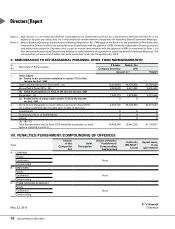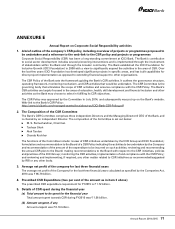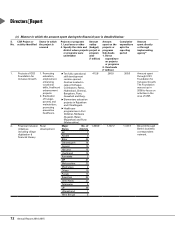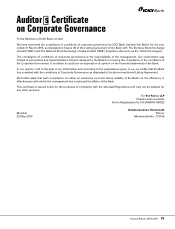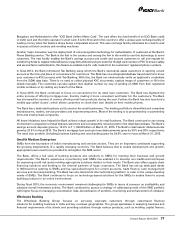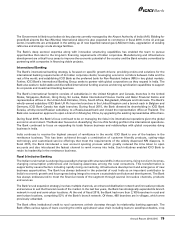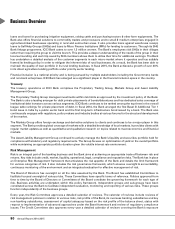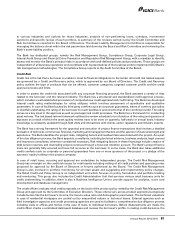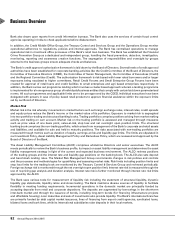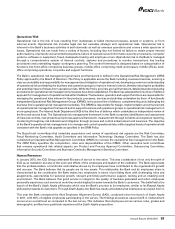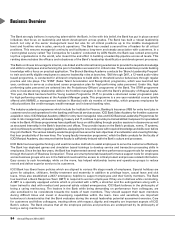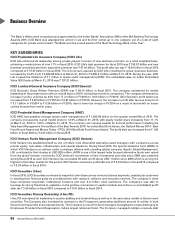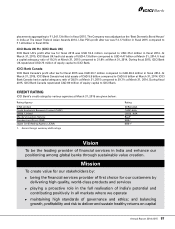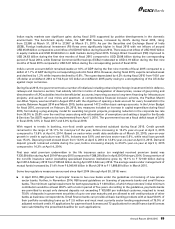ICICI Bank 2015 Annual Report Download - page 81
Download and view the complete annual report
Please find page 81 of the 2015 ICICI Bank annual report below. You can navigate through the pages in the report by either clicking on the pages listed below, or by using the keyword search tool below to find specific information within the annual report.
79Annual Report 2014-2015
The Government is likely to privatise six key airports currently managed by the Airport Authority of India (AAI). Bidding for
greenfield airports like Navi Mumbai International Airport is also expected to commence in fiscal 2016. In the oil and gas
sector, investments are anticipated in the setting up of new liquefied natural gas (LNG) terminals, upgradation of existing
refineries and strategic crude storage facilities.
The Bank’s deep sectoral expertise along with innovative structuring capabilities has enabled the team to pursue
opportunities that cater to the long-term financing requirements of Indian corporates. Manufacturing and infrastructure
development are critical focus areas to improve the economic potential of the country and the Bank remains committed to
partnering with companies in financing viable projects.
International Banking
The Bank’s international banking strategy is focused on specific growth drivers: providing end-to-end solutions for the
international banking requirements of its Indian corporate clients; leveraging economic corridors between India and the
rest of the world; and establishing ICICI Bank as the preferred bank for Non-Resident Indians (NRI) in key global markets.
Further, ICICI Bank’s International Banking Group seeks to partner with global corporations as they expand in India. The
Bank also seeks to build stable and diversified international funding sources and strong syndication capabilities to support
its corporate and investment banking business.
The Bank’s international footprint consists of subsidiaries in the United Kingdom and Canada, branches in the United
States, Singapore, Bahrain, Hong Kong, Sri Lanka, Dubai International Finance Centre and Qatar Financial Centre and
representative offices in the United Arab Emirates, China, South Africa, Bangladesh, Malaysia and Indonesia. The Bank’s
wholly-owned subsidiary ICICI Bank UK Plc has nine branches in the United Kingdom and a branch each in Belgium and
Germany. ICICI Bank Canada has eight branches. During fiscal 2015, the Bank divested its shareholding in ICICI Bank
Eurasia, wholly-owned Russian subsidiary, to a Russia-based bank and closed the representative office at Thailand. The
Bank also received an approval to open a branch in Shanghai, China, by upgrading the existing representative office there.
During fiscal 2015, the Bank’s focus continued to be on managing the risks in its international operations given the global
economic environment. The Bank also focused on diversifying the mix of its funding profile in the international operations.
The Bank continued to focus on expanding its trade finance business and relationships with global corporates doing
business in India.
India continues to receive the highest amount of remittance in the world. ICICI Bank is one of the leaders in the
remittance business. This has been achieved through a combination of customer friendly products, cutting-edge
technology and customised service offerings that meet the requirements of the widely dispersed NRI diaspora. In
fiscal 2015, the Bank introduced a new account opening process which greatly reduced the time taken to open
accounts and also introduced the fastest channel to remit money into India. Such initiatives enabled ICICI Bank to
retain its leadership in the remittance business.
Rural & Inclusive Banking
The Indian rural market is undergoing a paradigm change with structural shifts in the economy, rising non-farm incomes,
changing consumption preferences and increasing awareness among the rural consumers. This transformation is
supported by several factors including rapidly rising connectivity, infrastructure development and emergence of new
business opportunities. The Bank has always believed in the potential of rural India as an important contributor to
India’s economic growth and its progress being integral to ensure a sustainable and balanced development. The Bank
has always endeavoured to meet the financial needs of the segment through several innovative channels, products
and services.
The Bank’s rural expansion strategy involves multiple channels, an enhanced distribution network and innovative products
and services to suit the financial needs of the market. In the last few years, the Bank has strategically expanded its branch
network in rural and semi-urban locations. At the end of fiscal 2015, the Bank had more than 2,100 branches in rural and
semi-urban locations, comprising 52% of the Bank’s branch network. Of these, 460 branches are in villages, which were
previously unbanked.
The Bank offers institutional credit to rural customers at their doorstep through its relationship banking approach. The
Bank offers various types of loans covering the entire agricultural value chain including loans to seed/input dealers, crop


